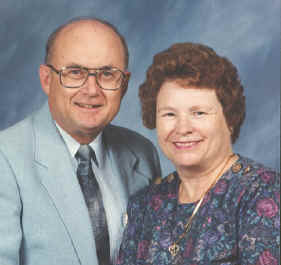

Having spent over 30 years as a research scientist, I guess it's not surprising that I would have an inclination for genealogical research. Also, my desire to know my relatives better, and my deep curiosity about our family's roots has made this research a very interesting avocation.
I grew up on a grain and livestock ranch near Jamestown, ND where my first interest in pedigrees involved the lineage of the registered Hereford cattle we raised. I always wanted to be a cattle rancher after I grew up but my college life led me into a much different field. I attended Jamestown College and received a B.S. degree in chemistry in 1958. In 1959, I began my career with the USDA Agricultural Research Service while completing an M.S. degree in soil science at the University of Arizona in Tucson. This career in agricultural research was as close as I would ever come to farming again.
It was in Tucson that I met my wife, Norma Harrington. We were married in 1961 and left Arizona for Corvallis, OR where I earned a Ph.D. in plant and soil science at Oregon State University. In 1966, I began a two-year postdoctoral research associateship at the Mineral Nutrition Pioneering Research Laboratory in Beltsville, MD. This was a unique experience working in the laboratory of Dr. Sterling Hendricks, perhaps the most renowned plant scientist in the U. S. Department of Agriculture. Moreover, we had a wonderful opportunity to experience Washington, D.C.
When the associateship ended in 1968, I transferred to the U. S. Salinity Laboratory in Riverside, CA where I worked as a research plant physiologist for the next 27 years. In 1975, I became the research leader of the Plant Sciences Group at the Lab and later was also appointed adjunct professor with the University of California, Riverside.
My research included studies of the salt tolerance of crops, mechanisms of ion uptake under saline conditions, interactive effects of salinity and air pollution, and the physiological effects of salt on plants. Results of this research were used to improve computer models that would predict the effect of soil salinity on the growth and development of a wheat crop. I have authored or co-authored over 100 scientific publications, including several book chapters, dealing with these subjects. My career took me to several foreign countries, including Australia, Germany, Israel, Italy, Pakistan, and Sicily to attend international conferences and workshops or confer with foreign scientists about salinity problems in irrigated agriculture.
In 1995, I accepted an invitation as a visiting scientist for six months at the Institute of Sustainable Irrigated Agriculture in Victoria, Australia. This provided a marvelous opportunity to become acquainted with Australia and its problems of salinity on their irrigated farm lands. Upon completion of this assignment, we returned home to Riverside to retirement.
